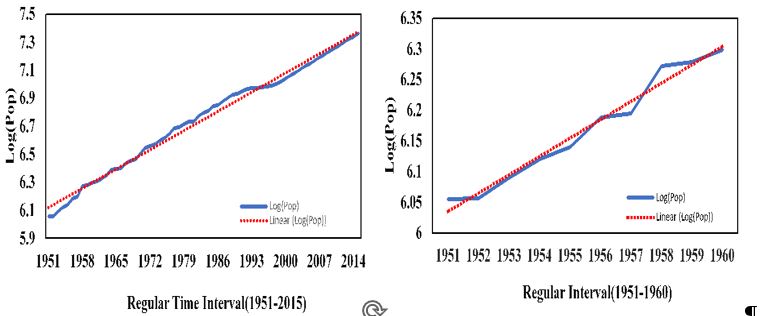Exploring the Spectrum Power Fractal Scaling Parameters by Hurst Range Increment - Second Order Moment Generation Techniques
Keywords:
Fractal Dimension (FD), Mann-Kendell test, Spectrum power fractal scaling, Hurst Range increment (HRange), Hurst Second Order Moment Generation (H2ndM)Abstract
Spectral power analysis was employed to assess the Fractal Dimension (FD) and explore fractal scaling using Hurst increment ranges and second-order moment relations in the context of urban population trends. This research aimed to scrutinize population trends in Karachi over both uneven periods (1729 to 1946) and even periods (1951 to 2020) using non-parametric Mann-Kendall tests and Hurst error accuracy testing. The primary focus was on analyzing spectrum power fractal scaling through Hurst exponent ranges and second-order moment generation. The FD results indicated irregular (1.371) and regular (1.058) intervals within the inequality range of 1 < D < 1.5. The log-population trend cumulatively increased from 3.0 in 1729 to 5.72 in 1946, and from 6.05 in 1951 to 7.36 in 2020, suggesting that the fractal dimension is more appropriately fitted for total regular intervals. The second-order and range exponents were H2ndM (0.60 ± 0.09) and H-Range (0.83 ± 0.05) for the uneven period (1729 to 1946), and H2ndM (0.85 ± 0.06) and H-Range (0.93 ± 0.02) for the even period (1951 to 2020). The study's results demonstrate that the range increment method is suitable and consistent across both long and short intervals. For regular intervals, the Hurst exponents show a linear relationship, indicating stability in the population trend analysis.
References
H. E. Hurst, “Long-Term Storage Capacity of Reservoirs,” Trans. Am. Soc. Civ. Eng., vol. 116, no. 1, pp. 770–799, Jan. 1951, doi: 10.1061/TACEAT.0006518.
P. J. Taylor, “Quantitative methods in geography : an introduction to spatial analysis,” p. 386, 25431BC.
Asma Zaffar, S. Abbas, and M. R. K. Ansari, “A Study of Largest Active Region AR12192 of 24th Solar Cycle Using Fractal Dimensions and Mathematical Morphology,” Sol. Syst. Res., vol. 54, no. 4, pp. 353–359, Jul. 2020, doi: 10.1134/S0038094620040012/METRICS.
S. Abbas and M. Ilyas, “Assessing the impact of EI Niño southern oscillation index and land surface temperature fluctuations on dengue fever outbreaks using ARIMAX(p)-PARX(p)-NBARX(p) models,” Arab. J. Geosci., vol. 11, no. 24, pp. 1–12, Dec. 2018, doi: 10.1007/S12517-018-4119-9/METRICS.
S. Katsev and I. L’Heureux, “Are Hurst exponents estimated from short or irregular time series meaningful?,” Comput. Geosci., vol. 29, no. 9, pp. 1085–1089, Nov. 2003, doi: 10.1016/S0098-3004(03)00105-5.
M. F. . Barnsley and H. Rising, Fractals everywhere. Academic Press Professional, 1993. Accessed: Sep. 01, 2024. [Online]. Available: http://www.sciencedirect.com:5070/book/9780120790616/fractals-everywhere
D. Hassan, S. Abbas, and & M. R. K. Ansari, “COMPARATIVE STUDY OF SOLAR FLARE NORTH-SOUTH HEMISPHERIC AND K-INDEX GEOMAGNETIC ACTIVITY TIME SERIES DATA USING FRACTAL DIMENSION,” Gomal Univ. J. Res., vol. 33, no. 1, pp. 72–79, Jun. 2017, Accessed: Sep. 01, 2024. [Online]. Available: http://www.gujr.com.pk/index.php/GUJR/article/view/84
“(PDF) Fractal analysis of time series and distribution properties of Hurst exponent.” Accessed: Sep. 01, 2024. [Online]. Available: https://www.researchgate.net/publication/281092858_Fractal_analysis_of_time_series_and_distribution_properties_of_Hurst_exponent
M. J. Kirkby, “The fractal geometry of nature. Benoit B. Mandelbrot. W. H. Freeman and co., San Francisco, 1982. No. of pages: 460. Price: £22.75 (hardback),” Earth Surf. Process. Landforms, vol. 8, no. 4, pp. 406–406, Jul. 1983, doi: 10.1002/ESP.3290080415.
K. Pollok, B. Jamtveit, and A. Putnis, “Analytical transmission electron microscopy of oscillatory zoned grandite garnets,” Contrib. to Mineral. Petrol., vol. 141, no. 3, pp. 358–366, 2001, doi: 10.1007/S004100100248.
G. L. Trigg, “Mathematical Tools for Physicists,” Math. Tools Phys., pp. 1–676, May 2006, doi: 10.1002/3527607773.
P. W. O. Hoskin, “Patterns of chaos: Fractal statistics and the oscillatory chemistry of zircon,” Geochim. Cosmochim. Acta, vol. 64, no. 11, pp. 1905–1923, Jun. 2000, doi: 10.1016/S0016-7037(00)00330-6.
J. B. Bassingthwaighte and G. M. Raymond, “Evaluation of the Dispersional Analysis Method for Fractal Time Series,” Ann. Biomed. Eng., vol. 23, no. 4, p. 491, Jul. 1995, doi: 10.1007/BF02584449.
J. Gao, Y. Cao, W. Tung, and J. Hu, “Basics of Fractal Geometry,” Multiscale Anal. Complex Time Ser., pp. 69–77, Aug. 2007, doi: 10.1002/9780470191651.CH5.
R. F. Mulligan, “The multifractal character of capacity utilization over the business cycle: An application of Hurst signature analysis,” Q. Rev. Econ. Financ., vol. 63, pp. 147–152, Feb. 2017, doi: 10.1016/j.qref.2016.04.016.
T. M. Tóth, “Fracture network characterization using 1D and 2D data of the Mórágy Granite body, southern Hungary,” J. Struct. Geol., vol. 113, pp. 176–187, Aug. 2018, doi: 10.1016/j.jsg.2018.05.029.
M. Tarnopolski, “Correlation between the Hurst exponent and the maximal Lyapunov exponent: Examining some low-dimensional conservative maps,” Phys. A Stat. Mech. its Appl., vol. 490, pp. 834–844, Jan. 2018, doi: 10.1016/j.physa.2017.08.159.
A. Mittal, S. S. Mallick, and P. W. Wypych, “An investigation into pressure fluctuations for fluidized dense-phase pneumatic transport of fine powders,” Powder Technol., vol. 277, pp. 163–170, Jun. 2015, doi: 10.1016/j.powtec.2015.02.052.
K. T. Park et al., “Characterization and expression of monoclonal antibody-defined molecules on resting and activated bovine αβ, γδ T and NK cells,” Vet. Immunol. Immunopathol., vol. 168, no. 1–2, pp. 118–130, Nov. 2015, doi: 10.1016/j.vetimm.2015.09.002.
C. Walck, “Hand-book on STATISTICAL DISTRIBUTIONS for experimentalists,” 1996.

Downloads
Published
How to Cite
Issue
Section
License
Copyright (c) 2024 50SEA

This work is licensed under a Creative Commons Attribution 4.0 International License.




















